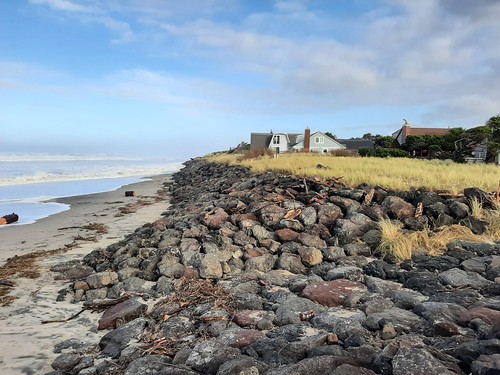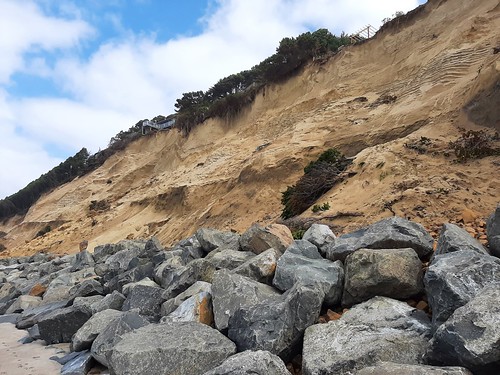Hi! My name is Hailey, and I am one of the new Natural Resource Policy Fellows. My fellowship is with the Oregon Coastal Management Program, which is administered by the Department of Land Conservation and Development. My entire education has been in engineering (I recently finished my Master’s degree in coastal engineering at OSU), but I’m excited to dip my toes into the policy world and make connections between the two fields.
Goal 18 is one of Oregon’s land use planning goals, and it governs the beaches and dunes of the Oregon coast. It limits the construction of hard, protective structures (riprap is the most common example on the OR coast), prevents excessive dune grading, and makes sure development does not occur on beaches or active dunes. The provisions of Goal 18 are relatively simple, but can be difficult to implement. For example, the goal doesn’t contain an explicit definition of “beachfront protective structures,” which are prohibited on properties developed after January 1, 1977. As engineers and scientists continue to study innovative strategies for erosion control, it is becoming less clear which erosion control options fall under the category of “beachfront protective structures.” This lack of clarity on what constitutes a structure is just one example of the need for more guidance on erosion control. For my fellowship, I’ll aim to close this knowledge gap by developing a comprehensive guidebook on Oregon coast erosion control practices for planners, engineers, homeowners, and any other interested parties.
Part of the reasoning for the limitation on beachfront protective structures in Goal 18 dates back to the 1967 Beach Bill, which provided the public with uninterrupted access to Oregon beaches. The challenge of enforcing this bill is that the location of the beach can change through erosion or accretion without regard to tax lots, private property rights, and other human boundaries. The public is therefore granted an easement onto private property if that property extends onto the beach. This means that while portions of the beach can still be owned by private property owners, the public has a right to use them.
This system works well enough when changes in the location of the beach are small. But the situation becomes direr when erosion creeps towards homes, sewer systems, and other infrastructure. Naturally, property owners turn to engineering solutions like riprap or seawalls to stop the erosion and protect their home. However, these solutions can be problematic. Hard structures that fix the shoreline in place cause the beach in front of the structure to lower and trap sand from entering the beach system. As sea level rises, water levels will reach farther onto the beach, leading to reduced or no beach access over time.
For this reason, 10 years after the passage of the beach bill, Goal 18 included a provision to preserve the beach for the public by preventing the construction of beachfront protective structures and the subsequent reduction in beach width. However, any private development built before the goal was implemented was considered exempt from this rule. Goal 18 is short (only 5 pages, linked here), but has significant impacts because it determines what coastal development can be structurally protected from erosion.
It’s important to note that erosion is not inherently a bad thing. Erosion and accretion of the coast are completely natural processes that are caused by a huge range of factors including long-term weather patterns, creek migration, individual storms, and jetty construction. However, building as close to the beach as possible sets the dynamic nature of the coast in direct conflict with the protection of development.
This winter’s storms and associated erosion threatened coastal infrastructure in a few hotspots on the coast. While the storms didn’t have unusually high wave heights, they were long period (high energy) waves, and occurred during one of the highest tides of the year.
There were several hotspots of significant erosion. On the Salishan spit, a rip embayment caused the collapse of some old riprap, leaving houses unprotected. It was only through quick action by contractors and an emergency permit from the Oregon Parks and Recreation Department (OPRD) that the houses were saved.
In Gleneden beach, a large landslide is threatening homes. Some homeowners have installed riprap at the toe (bottom) of the landslide to prevent further sliding.
In Lincoln Beach, another rip embayment caused the collapse of a retaining wall structure in front of a house. This property is not eligible for riprap according to Goal 18 rules, and erosion was significant enough to threaten the house. More information is available about this situation in an article by the Newport News times (here). The homeowners, the county, and OPRD have agreed to install a temporary support beam under the house for protection while debris is cleaned up, and to protect the house while the homeowners pursue an exception to their Goal 18 ineligibility. That local goal exception process is a public process that will ultimately be decided by Lincoln County’s Board of County Commissioners.
After a very erosive winter, erosion mitigation and Goal 18 are hot topics on the Oregon coast. My project feels exciting and timely, and I hope my final product will be useful in addressing some of these challenges on the coast. In a time when all my work is remote and I haven’t met anyone I’m working with in person, it is especially meaningful to see the relevance of my work. I’m looking forward to providing updates on my project and developments on the coast throughout the rest of my fellowship.







You have chosen to work in a very interesting, challenging and dynamic field. With the likelihood of even more beach front retreat due to increasing sea level and higher storm surge, it needs new insights, new technologies and fresh policy approaches to cope with these changes. May the Force be with you !!
Great post, Hailey! It seems like you are quickly getting immersed in the policy realm and that your coastal engineering degree will serve you well as you work on the Guidebook. This is a great primer for readers unfamiliar with Goal 18 and the incredibly complex nature of beach front property. I am excited to follow along and continue learning about your work!